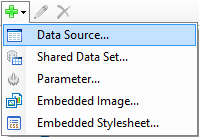In Page and RDL reports, you connect to a data source in the Report Explorer.
- In the Report Explorer, right-click the Data Sources node and select Add Data Source, or from the Add button select Data Source.

- In the Report Data Source dialog that appears, on the General page, change the name of the data source (DataSource1 by default). This name appears in the Report Explorer as a child of the Data Sources node, so it is useful to give it a meaningful name.
- Under Type, select the type of data source you want to use.
- Under Connection, enter the Connection String.
If you select SQL, OleDB, or Oracle for the Type, Connection Properties, Connection String, and Advanced Settings pages appear under Connection. See Report Data Source Dialog in the ActiveReports User Guide for further details.
If you select XML Provider for the Type, the connection string must include XmlDoc or XmlData. (TransformationDoc is optional.)XML Provider Connection Strings
- XmlDoc: Refers to a specific XML file located on either the file system or at a web-accessible location. For example,
XmlDoc=C:\MyXmlFile.xml; - XmlData: Provides XML data in the connection string itself. For example,
XmlData=<people>
<person>
<name>
<given>John</given>
<family>Doe</family>
</name>
</person>
<person>
<name>
<given>Jane</given>
<family>Smith</family>
</name>
</person>
</people>; - TransformationDoc: Refers to a specific XSLT file to apply to the XML data.
Note that elements in the Connection String must terminate with a semicolon (;) character.
- XmlDoc: Refers to a specific XML file located on either the file system or at a web-accessible location. For example,
- Click the Validate Data Source icon
 to confirm the connection string. This icon becomes inactive to indicate success, or an error message indicates an invalid connection string.
to confirm the connection string. This icon becomes inactive to indicate success, or an error message indicates an invalid connection string.
- On the Credentials page, you can specify your password, request user credentials, or use Windows authentication.
- Click the OK button on the lower right corner to close the dialog. You have successfully connected the report to a data source.
In ActiveReports, you can connect to most data sources with these steps. However, you need to follow the instructions below to connect to a Shared Data Source on ActiveReports Server.
Connect to a Shared Data Source
- In the Report Explorer, right-click the Data Sources node and select the Add Data Source option or select Data Source from the Add button.
- In the Report Data Source dialog that appears, select the General page and enter the name of the data source. This name appears as a child node to the Data Sources node in the Report Explorer.
- Check the Shared Reference checkbox on.
- Under Reference, click the Browse button and from the Shared Data Source File dialog that appears, go to the folder where your shared data source file is located and select it. A file path appears in the field adjacent to the Browse button.
- Click the OK button on the lower right corner to close the dialog. A shared data source node appears in the Report Explorer.